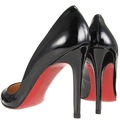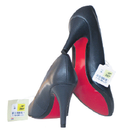Advocate General Delivers Opinion on Louboutin’s Red Sole Trademark
 On June 22 2017 Advocate General Maciej Szpunar of the European Court of Justice (ECJ) delivered his opinion in the Christian Louboutin v Van Haren Schoenen BV case, stating that the prohibition contained in Article 3(1)(e)(iii) of Directive 2008/95 could potentially apply to Louboutin’s red sole trademark.
On June 22 2017 Advocate General Maciej Szpunar of the European Court of Justice (ECJ) delivered his opinion in the Christian Louboutin v Van Haren Schoenen BV case, stating that the prohibition contained in Article 3(1)(e)(iii) of Directive 2008/95 could potentially apply to Louboutin’s red sole trademark.
 The District Court of The Hague asked the ECJ if the notion of ‘shape’ within the meaning of Article 3(1)(e) (iii) of Directive 2008/95 is limited to the three-dimensional properties of goods, such as their contours, measurements and volume (expressed three-dimensionally), or if it includes other (non 3D) properties of goods, such as their colour.
The District Court of The Hague asked the ECJ if the notion of ‘shape’ within the meaning of Article 3(1)(e) (iii) of Directive 2008/95 is limited to the three-dimensional properties of goods, such as their contours, measurements and volume (expressed three-dimensionally), or if it includes other (non 3D) properties of goods, such as their colour.
The question was referred to the ECJ after Van Haren appealed the decision of The Hague Court which stated that it had infringed Louboutin’s Benelux trademark for a high-heeled shoe with a red sole. The trademark was described as consisting of “the colour red (Pantone 18 1663TP) applied to the sole of a shoe as depicted (the contour of the shoe is not part of the trademark but is intended to show the positioning of the mark)”. Louboutin had sued Van Haren for infringement because it was selling dark-coloured high-heeled shoes with red soles. The Hague Court ruled that Louboutin’s trademark had characteristics of both a colour mark and a 3D mark because the colour red is positioned on the sole of a high-heeled shoe, that it had acquired distinctiveness through Louboutin’s use, and that the coloured sole gave substantial value to the shoes.
In its appeal, Van Haren argued that Louboutin’s trademark was invalid, pursuant to Article 2.1(2) of the Benelux Convention on Intellectual Property (the equivalent of Article 3(1)(e)(iii) of Directive 2008/95) which excludes from registration or, if registered, makes liable to being declared invalid:
“e) signs which consist exclusively of:
i) the shape which results from the nature of the goods themselves;
ii) the shape of goods which is necessary to obtain a technical result;
iii) the shape which gives substantial value to the goods;”
The advocate general stated that, in his opinion, Louboutin’s trademark did not consist of a colour per se; rather, it was classified as consisting of the shape of the goods and seeking protection for a colour in relation to that shape. He also stated that Article 3(1)(e)(iii) of Directive 2008/95 is applicable to such signs, which must be subject to the functional analysis provided for by the article.
In his opinion, however, the concept of a shape which “gives substantial value” to the goods, within the meaning of that provision, relates only to the intrinsic value of the shape, and does not take into account the reputation of the mark or its proprietor.
He stated that the presence of a colour on the surface of goods can be regarded as a characteristic reflected in the shape of the goods; that a colour can be an essential practical characteristic of certain goods, such that the monopolisation of colour in relation to an element of the shape of the goods would remove the freedom of competitors to offer goods incorporating the same functionality; and that, finally, the functionality of a colour may emerge from its positioning on the goods such that it is essential that the two aspects – shape and colour – be examined together.
The final ruling of the ECJ should follow in about six months. If the ECJ follows the advocate general’s opinion, then The Hague Court will probably subject Louboutin’s trademark to the functional analysis provided for by Article 3(1)(e)(iii).
By Roxana Sarghi, Senior Trademark and Patent Paralegal at PETOŠEVIĆ Romania
This article first appeared on WTR Daily, part of World Trademark Review, in July 2017. For further information, please go to www.worldtrademarkreview.com.
